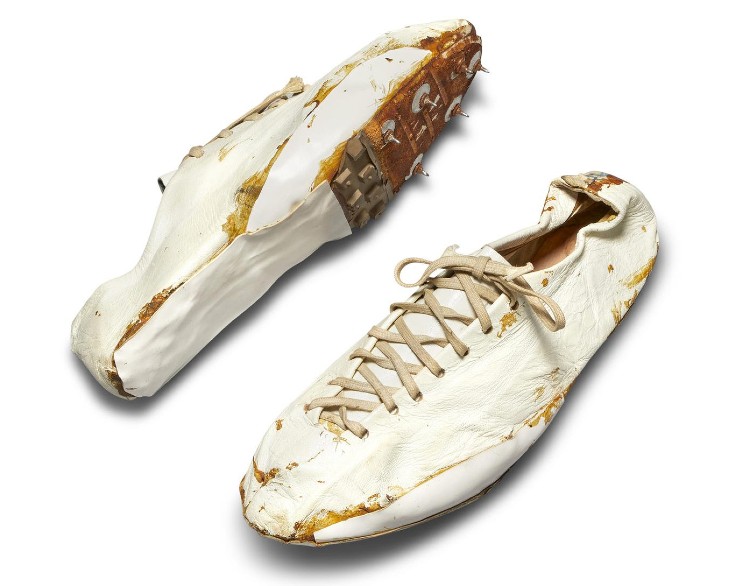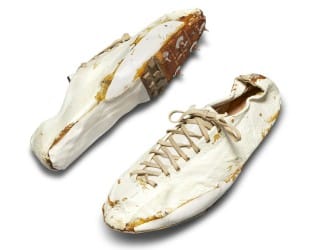
NEW YORK – Sotheby’s is conducting a special single-lot online auction of a pair of waffle spike shoes handmade in the early 1970s by Bill Bowerman, the co-founder of Nike and legendary University of Oregon track coach. The Nike Origins | Bowerman Built auction is open for bidding through June 26.
Bowerman created the waffle spike shoes exclusively for John Mays, a runner on his University of Oregon track team, and have remained in Mays’ possession ever since. One of only a handful of pairs known to exist, these shoes mark the first and only pair handcrafted by Bowerman ever to appear at auction. Another known pair of Bowerman shoes are in the Special Collections and University Archives of the Knight Library at the University of Oregon.
Legendary Oregon runner Phil Knight and Bowerman partnered together and started Blue Ribbon Sports in 1964, which was rebranded as Nike in 1971. Bowerman crafted the present shoes in the early 1970s during the Blue Ribbon Sports era, but later modified them in 1974 with Nike’s first major innovation, the waffle soles. As such, these shoes uniquely straddle the formation of the world’s largest athletic brand.
Estimated to sell for $130,000/$150,000, the present shoes are among the most valuable pair ever offered at auction, following Sotheby’s record-breaking sale of Michael Jordan’s game-worn autographed Nike Air Jordan 1s from 1985 that achieved $560,000 at Sotheby’s just last month. The Air Jordans established a new world auction record for any pair of sneakers – surpassing the previous auction record of $437,500, set at Sotheby’s in July 2019 by the Nike Waffle Racing Flat “Moon Shoe.”
Consignor John Mays said: “Often times, Bill would talk to me about a new company he was involved with. I didn’t pay much attention to it at the time. One day, he asked me to help test a new sprint spike shoe he was designing. Of course, I agreed and was excited to be chosen. He took measurements of my feet and started building the shoe, and in about a week he had the shoes ready for me. Bill had me test the shoes by running in them during practice and in meets. I gave him feedback about the feel of the shoes; if they were comfortable, if the footplate was too hard, if they tore and where. As seen in the accompanying letter, he left me notes to tell me what type of workouts he wanted me to put the shoes through. Bill continued to make revisions on the sprint shoes, even to the point of writing my name on them. Eventually, I wore them in the NCAA Track and Field Championships and the 1972 Olympic Trials in Eugene.”
“The pair speaks volumes to Bill’s need to constantly innovate, showing multiple layers of modifications, including the addition of a waffle sole on the right shoe – an elemental design that Nike still uses today,” said Brahm Wachter, Sotheby’s director of eCommerce Development.
Obsessed with weight and performance, Bowerman would build shoes for his University of Oregon runners from scratch, often using an assemblage of raw materials.
The present shoes were produced in the early 1970s for University of Oregon track runner, John Mays. They were later adjusted in 1974 by Bowerman, after which they were never used again. The shoes have their original laces, and the aglets are frayed from wear. The lace-holes were hand-punched by Bowerman, and there are a total of 14 of them on each shoe. On the heels, the shoes say “MAYS” in Bill Bowerman’s handwriting.
Notably, the soles on these shoes do not match one another. The right shoe demonstrates a beautiful example of Bowerman’s need to innovate, displaying a design he thought might be effective for Mays – incorporating a waffle sole that is absent on the left shoe. The waffles of course, represent an important moment in the history of footwear, as Bill invented the design after being inspired by his wife’s waffle iron. The spikes do show wear, but the waffles and the back half of the right shoe appear mint. The reason for this is that Bowerman was constantly tinkering and modifying his shoes, and he added the waffles and a strip of white material to the right shoe for Mays to test in 1974.
Though Mays never tested the modified shoe with the waffle sole, the pair is elemental to the genesis of Nike, and represents Bowerman’s legacy as an innovator.



